The Legislative Council was formed in 1823. At the time the Council consisted of five members and met at Government House or the residence of the Chief Justice.
In 1828, the Council was enlarged to between 10 and 15 members. To accommodate the additional members, the Council moved to occupy the northern downstairs room of the Principal Surgeon’s Quarters in Governor Macquarie’s “Rum Hospital”. To this day the “Rum Hospital” forms the façade of the present Parliament building.
 Macquarie’s “Rum Hospital”, completed in 1816. The Parliament now occupies the left-hand building, then the Principal Surgeon’s Quarters. The Legislative Council first met in the downstairs room on the far left.
Macquarie’s “Rum Hospital”, completed in 1816. The Parliament now occupies the left-hand building, then the Principal Surgeon’s Quarters. The Legislative Council first met in the downstairs room on the far left.
In 1843, the size of the Legislative Council was further increased to 36 members (with two-thirds of them elected). A larger Chamber was needed and was constructed on the northern end of the Principal Surgeon’s Quarters. This is the Chamber now used by the Legislative Assembly.
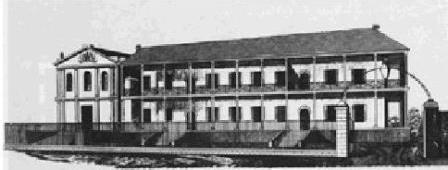 The new Council Chamber added to the north side of the Principal Surgeon’s Quarters in 1843.
The new Council Chamber added to the north side of the Principal Surgeon’s Quarters in 1843.
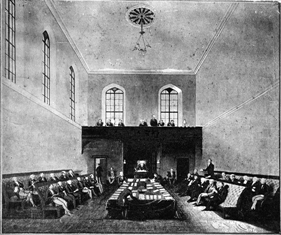 Image of the Legislative Council Chamber in 1843. The Chamber is now used by the Legislative Assembly.
Image of the Legislative Council Chamber in 1843. The Chamber is now used by the Legislative Assembly.
Between 1843 and the early 1850s, there ensued an extended period of struggle for self government and independence for the colony. By 1853, a proposal for a system of responsible government, with a two-house elected Parliament comprising of the existing Legislative Council and a new Legislative Assembly, had been agreed in principle.
Faced with the imminent establishment of responsible government, and the creation of the Legislative Assembly, it became imperative to find more accommodation to house the new bicameral Parliament. The Legislative Assembly would henceforth occupy the Chamber previously occupied by the Legislative Council. Accordingly, new premises needed to be found for the Legislative Council. This was not an easy task when building materials and skilled labour were in short supply due to the gold rushes.
In 1855, very little progress having been made towards the finding of suitable new premises for the Legislative Council, the Governor authorised the purchase of a prefabricated iron hall which was sitting on the docks in Melbourne, destined for the goldfields. The building was purchased in 1855 for £1,835 and shipped from Melbourne to Sydney and erected on its current site on the south side of the Parliament building. Due to the shortage of building materials, the packing crates used to transport the building were re-used as internal boarding of the walls of the Chamber. Some of the packing remains there to this day.
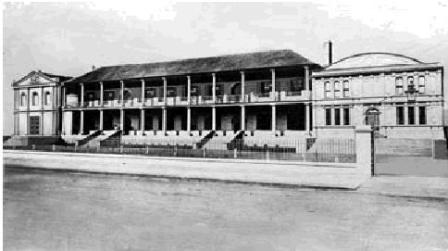 The new Council Chamber added to the south side of the Parliament building in 1856.
The new Council Chamber added to the south side of the Parliament building in 1856.
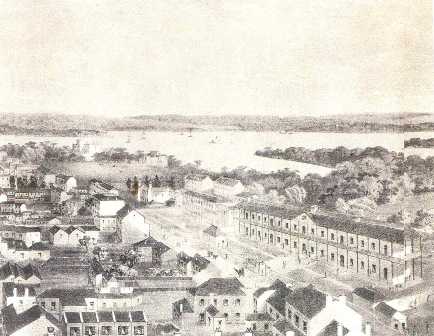 The Parliament building in 1856 with the two Chambers in place, seen next to the main building of the “Rum Hospital”.
The Parliament building in 1856 with the two Chambers in place, seen next to the main building of the “Rum Hospital”.
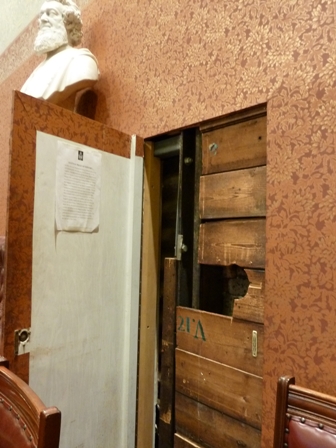 The original packing used to transport the prefabricated Legislative Council building to Sydney, and then used as internal boarding of the walls.
The original packing used to transport the prefabricated Legislative Council building to Sydney, and then used as internal boarding of the walls.
The new gas-lit Council Chamber had its faults; there were ventilation problems, the Chamber was too hot in summer and the rain beating on the roof caused serious acoustic problems. Within two years of construction the original curved corrugated iron and slate roof was leaking. In 1859, the iron roof was replaced with a timber trussed pitched roof of slate. This also necessitated modifications to the curved iron façade.
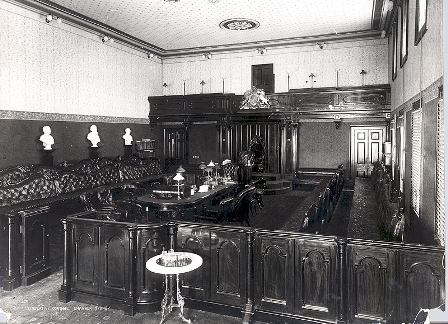 The Council Chamber in the 1890s.
The Council Chamber in the 1890s.
In 1892-1893, the Chamber was enlarged when the façade was moved three metres closer to Macquarie Street.
By the 1920s, the Chamber was showing signs of imminent collapse due to the deterioration of the southern outer corrugated iron wall. Large wooden props were installed in the Chamber to support the ceiling, while others buttressed the south wall against Sydney Hospital.
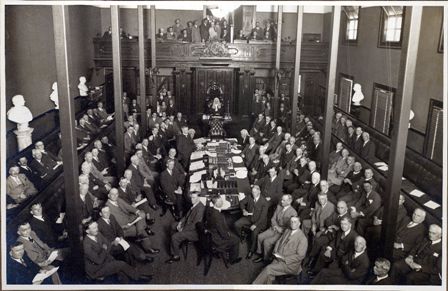 The Council Chamber in November 1933 showing the buttressing of the ceiling.
The Council Chamber in November 1933 showing the buttressing of the ceiling.
The southern wall, which faces the hospital, was reconstructed in the 1930s obviating the need for wooden props.
In 1974, when the worn carpet of the Chamber was removed for replacement, it was discovered that a colony of white ants had been feasting for some time on the floor joists and floorboards. This resulted in replacement of the whole floor and of the Chamber and lower gallery. All manner of interesting things were found beneath the floor including timbers and sandstone columns from the original Principal Surgeon’s Quarters. The sandstone columns were subsequently used in the restoration of the Mint building.
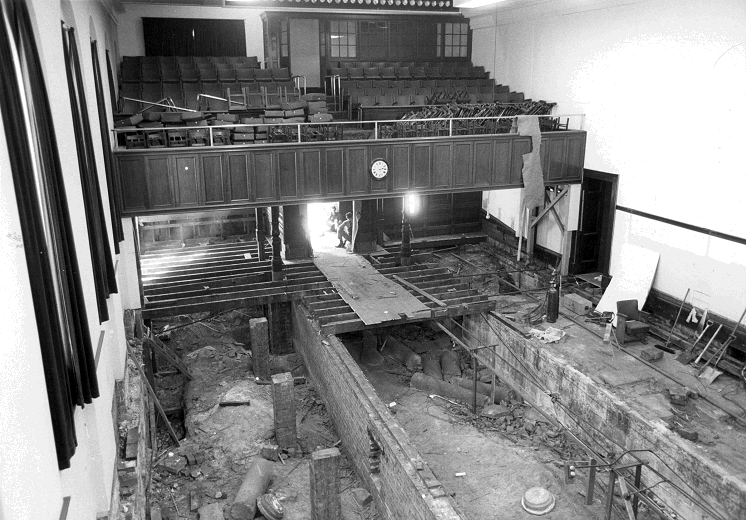 The Council Chamber with the floorboards removed in 1974.
The Council Chamber with the floorboards removed in 1974.
Before the floorboards were re-laid, numerous items were placed below for future generations to discover. At the same time, when the members’ benches were stripped by the upholsterer it was discovered that, although their cedar scroll work had been doctored and covered up, they were the original benches from 1856. One of these benches was restored to its appearance in 1886 and may now be seen, and sat on, in the Council foyer.
The Chamber was further renovated in the period 1974-1980 to appear as it did in photographs of 1892. At the time, some of the original wallpaper and paint was found behind the ghastly whiteness of ‘public works’ paint of later eras. The wallpaper was used to determine the decoration of the renovated Chamber.
In more recent times the seating in the chamber has been altered to accommodate increasing numbers of members from minor parties and independents. The benches across the western end of the chamber, known as the ‘cross benches’, have been expanded, and the front benches on the northern and southern sides of the chamber have been divided towards the western ends.
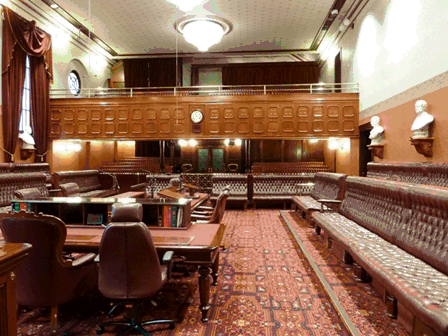
Further improvements to the chamber have also been made in line with modern technology including the installation of downlights and halogen lights, sound amplification, an electronic timing system, network cabling for laptop computers and an in-house video system with video titling feeding to live internet broadcasts of the House’s proceedings.
Formerly, the Royal Arms of the United Kingdom hung in the chamber above the dais. However, in 2006 the House passed a resolution authorising the President to replace the Royal Arms with the State Arms of New South Wales, in accordance with the spirit of the
State Arms, Symbols and Emblems Act 2004. The Royal Arms were relocated to elsewhere in the Parliament.
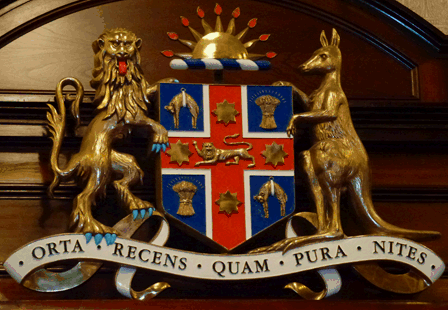
While the Council Chamber has been bandaged, propped up, eaten by white ants, painted and finally restored to its 1890s internal appearance, the original prefabricated iron building remains the meeting place of democracy after over 150 years.
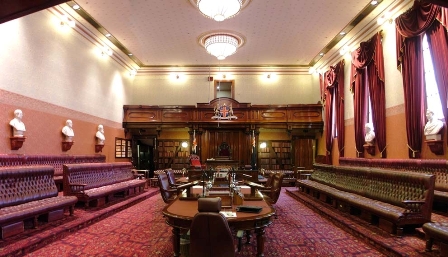 The modern Council Chamber.
More information
The modern Council Chamber.
More information
